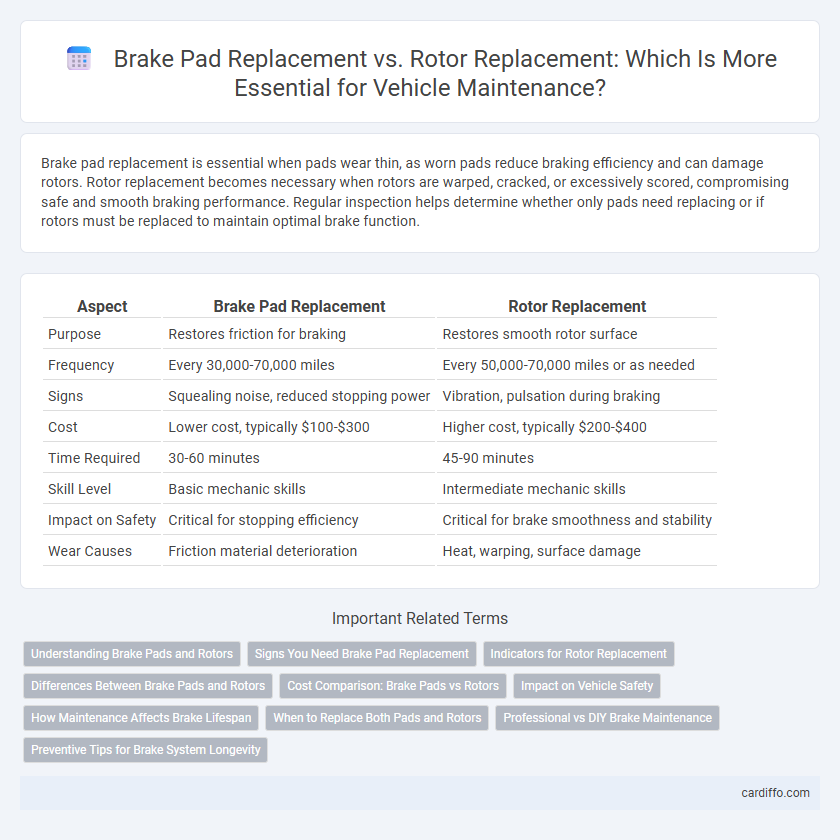Brake pad replacement is essential when pads wear thin, as worn pads reduce braking efficiency and can damage rotors. Rotor replacement becomes necessary when rotors are warped, cracked, or excessively scored, compromising safe and smooth braking performance. Regular inspection helps determine whether only pads need replacing or if rotors must be replaced to maintain optimal brake function.
Table of Comparison
| Aspect | Brake Pad Replacement | Rotor Replacement |
|---|---|---|
| Purpose | Restores friction for braking | Restores smooth rotor surface |
| Frequency | Every 30,000-70,000 miles | Every 50,000-70,000 miles or as needed |
| Signs | Squealing noise, reduced stopping power | Vibration, pulsation during braking |
| Cost | Lower cost, typically $100-$300 | Higher cost, typically $200-$400 |
| Time Required | 30-60 minutes | 45-90 minutes |
| Skill Level | Basic mechanic skills | Intermediate mechanic skills |
| Impact on Safety | Critical for stopping efficiency | Critical for brake smoothness and stability |
| Wear Causes | Friction material deterioration | Heat, warping, surface damage |
Understanding Brake Pads and Rotors
Brake pads and rotors are critical components of a vehicle's braking system, where pads provide the friction needed to slow down the wheels, and rotors serve as the surfaces that the pads press against. Brake pad replacement is necessary when the pads wear down, typically after 30,000 to 70,000 miles, while rotor replacement depends on factors like thickness, warping, or scoring. Proper maintenance ensures optimal braking performance, safety, and extends the lifespan of both brake pads and rotors.
Signs You Need Brake Pad Replacement
Worn brake pads often cause squealing or grinding noises when braking, signaling it's time for replacement. A noticeable decrease in braking performance or a longer stopping distance indicates brake pad wear affecting safety. Visual inspection revealing pads thinner than 3 millimeters confirms the need for immediate brake pad replacement.
Indicators for Rotor Replacement
Rotor replacement is indicated by visible deep grooves, significant warping, or thinning below the manufacturer's minimum thickness specification. Persistent vibration or pulsation during braking signals potential rotor damage requiring replacement to ensure safety. Measuring rotor thickness with a micrometer confirms whether replacement is necessary, preventing brake system failure.
Differences Between Brake Pads and Rotors
Brake pads are friction materials that press against the rotors to slow or stop a vehicle, while rotors are metal discs that provide the surface for this friction. Brake pads wear down faster due to direct contact and require more frequent replacement, whereas rotors can last longer but may need resurfacing or replacement if warped or excessively worn. Understanding these differences is crucial for effective brake maintenance and optimal vehicle safety.
Cost Comparison: Brake Pads vs Rotors
Brake pad replacement typically costs between $150 and $300, while rotor replacement ranges from $200 to $400 per axle, making rotors generally more expensive due to materials and labor. Brake pads wear out faster and require more frequent replacement compared to rotors, influencing the long-term maintenance cost. Choosing to resurface rotors instead of replacing them can reduce expenses but may not be viable if the rotor thickness is below safety standards.
Impact on Vehicle Safety
Brake pad replacement directly enhances vehicle safety by restoring effective braking performance and reducing stopping distances, which is critical for accident prevention. Rotor replacement ensures a smooth and stable braking surface, preventing vibrations and potential brake failure that can compromise driver control. Neglecting rotor condition during brake pad changes can lead to uneven wear and diminished safety, making both replacements essential for optimal braking system reliability.
How Maintenance Affects Brake Lifespan
Regular brake maintenance significantly extends brake lifespan by preventing uneven wear on both brake pads and rotors. Replacing brake pads promptly ensures optimal contact with rotors, reducing heat buildup and minimizing rotor warping or scoring. Neglecting timely rotor inspection and replacement can lead to increased vibrations, noise, and accelerated brake component wear, ultimately escalating repair costs.
When to Replace Both Pads and Rotors
Brake pad replacement should occur when pads are worn down to 3mm or less, while rotor replacement is necessary if rotors exhibit deep grooves, warping, or thickness below manufacturer minimum specifications. Both pads and rotors must be replaced simultaneously when rotor damage has caused uneven wear on new pads, leading to decreased braking efficiency and increased vibration. Inspecting rotor thickness, surface condition, and pad wear during routine maintenance ensures optimal brake system performance and safety.
Professional vs DIY Brake Maintenance
Professional brake pad replacement ensures precise rotor inspection and prevents uneven wear, which DIY brake maintenance often overlooks, leading to costly rotor damage. Certified mechanics use specialized tools to measure rotor thickness and detect warping, guaranteeing optimal braking performance and safety. DIY brake maintenance may save money initially but risks incomplete rotor evaluation, increasing the likelihood of premature rotor replacement and compromised vehicle safety.
Preventive Tips for Brake System Longevity
Regularly inspect brake pads for wear and replace them before they reach the minimum thickness to prevent rotor damage. Maintaining clean rotors and avoiding aggressive braking reduces heat buildup and extends rotor lifespan. Use high-quality brake components and schedule routine brake system checks to ensure optimal performance and safety.
Brake Pad Replacement vs Rotor Replacement Infographic

 cardiffo.com
cardiffo.com